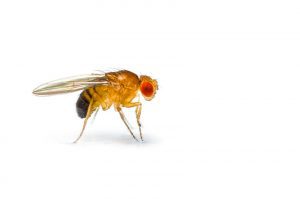Identification and Life Cycle
The three types of filth flies commonly found in homes is the Fruit Fly (Drosophila spp.), Drain Fly (Psychodidae spp.), and Phorid Fly (Phoridae spp.).
The Fruit Fly is small in size, approximately 1/8 – inch long, has large red eyes and a tan thorax. The abdomen is black on the top and gray in color underneath. They can grow from an egg to an adult in just 8-10 days, and their life span can be approximately 2 weeks. Fruit flies can lay up to 500 eggs in thier short lifetime.
The Drain Fly, also known as the Drain Moth, is about 1/8 inch long and is frequently mistaken for gnats and fruit flies. Its body is dark gray and broad, with fuzzy wings lighter in color. Their life cylce can be completed in one to three weeks and the adults can live up to 2 weeks, laying eggs in masses of 30 to 100.
The Phorid Fly, or “humpbacked” fly is very small in size, 1/16 to 1/8 –inches long. It is black to a dullish brown in color, but some are yellowish. Its high arched thorax gives it a humpbacked appearance. Their life span from an egg to an adult can be as short as 14 days, and the female can lay up to 750 eggs in her lifetime.
All flies belong to the insect order, Dipetera, meaning “two-winged”. A filth flies life cycle consist of 4 stages; egg, larva, pupa and adult. Eggs are laid in a variety of decaying or organic matter and hatch into larva (resembling pale maggots), then they pupate. At this time they do not feed, and soon emerge as an adult in 7-14 days.



Comments are closed.